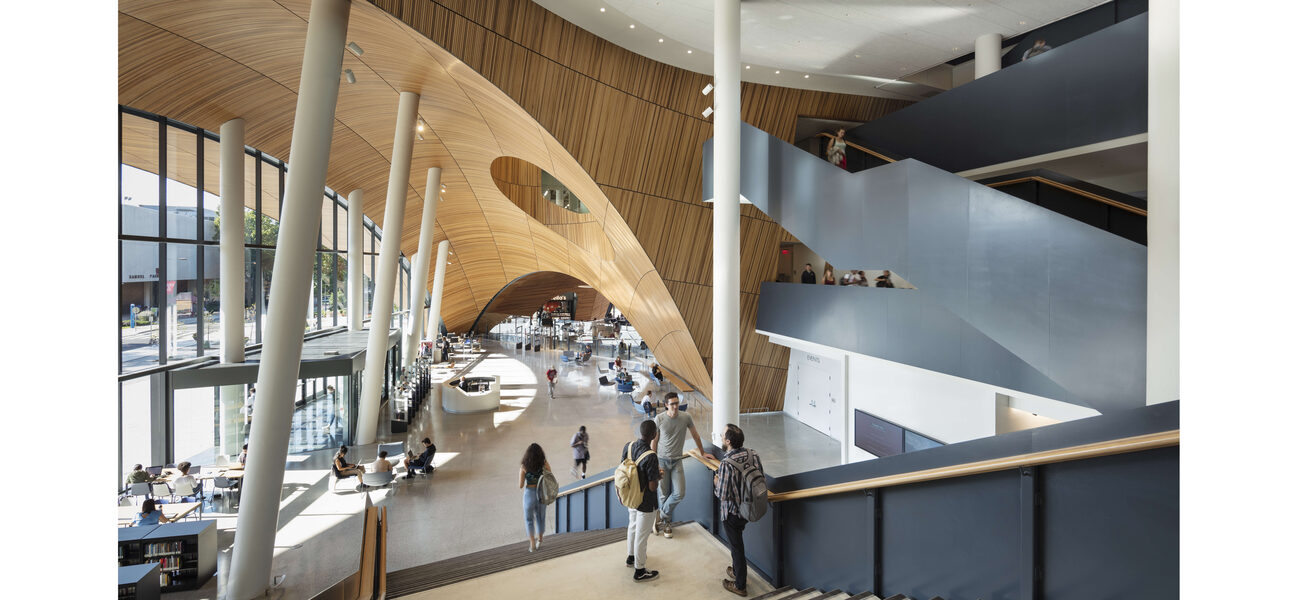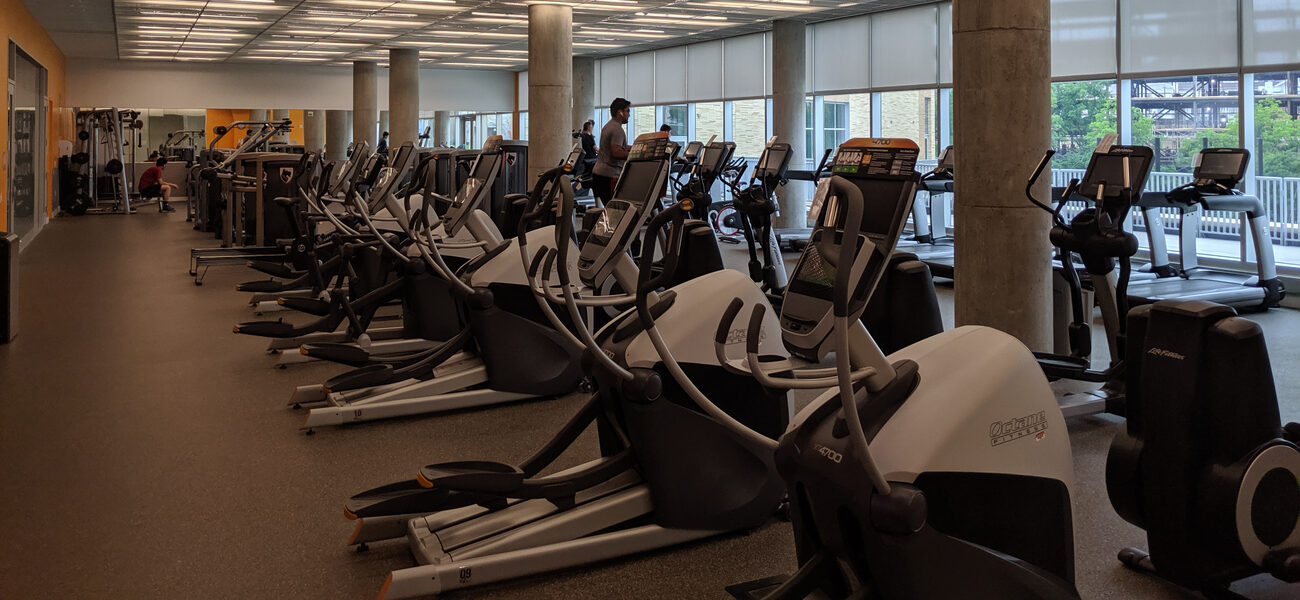How are library, fitness, dining, and office spaces used in higher education? How does that use compare before and after the pandemic, and how does it vary over the course of a day and from institution to institution? How can higher ed leaders use space occupancy data to make better informed decisions about how much space to provide, where to locate it, and when to operate it?
These are the questions brightspot and our colleagues in the Buro Happold analytics team set out to answer in collaboration with the occupancy monitoring company, Occuspace.
Occuspace provided anonymized space utilization data from 140 spaces at 38 universities across the U.S. and Canada along with institutional attributes like enrollment, operating hours, library print collection size, the presence of student success functions within libraries, proximity to related/complementary functions, and more. We then analyzed the historical foot traffic data from library, fitness, dining, and office spaces to shed light on these questions.
In this white paper, we present seven insights to help higher education leaders better plan and operate their facilities based on occupancy trends:
- Consolidation of satellite library locations
- Shifting library space from book stacks to study space
- Optimizing adjacencies among library, dining, and classroom space
- Including student success partners within libraries
- Matching operating hours and offerings with usage
- Right-sizing workplaces to match hybrid work patterns
- Linking occupancy data with other analyses to define what being “full” means
Some of the insights may be surprising and get you thinking differently about how you operate your spaces, such as the events and programs in them, the systems you use to monitor and manage them, how you staff them, and other critical space management needs. Other insights may confirm your intuition and give you the data to make data-supported arguments about facilities and operational changes. Let’s dig in.
Data Sources and Methodology
We analyzed aggregated Occuspace occupancy sensor data from multiple institutions and space types to identify patterns that will help us to understand current space use and to inform future real estate decisions. The Occuspace customer data in this white paper was completely anonymized. All data is presented in an aggregated, normalized format. Specific measures were taken to safeguard the confidentiality of customer data. brightspot analyzed these anonymized data with broad meta information regarding facility types and school characteristics, enabling the analysis of the different variables to identify unique patterns across higher education campuses.
Analyzing data from a pre- and post-pandemic view, we looked at overall, weekly, and daily utilization for libraries, dining, workspace, and fitness spaces. The implementation of the sensors increased significantly after the pandemic, going from three institutions and 12 space zones in 2019, to 38 institutions and 140 space zones in 2023. From this view, we developed trends that provide insight on how and when spaces are being used. This data allows for informed decision-making, efficient resource allocation, and improved user experiences. Because the sample size of institutions collecting data in 2019-20 is limited to three, we emphasize insights drawn from the larger pool of 38 universities from 2021 onward in most of our findings but do make pre- to post-pandemic comparisons when useful.
Insight 1: Main Library Locations Are Used 40% More Than Satellite Libraries
Many academic libraries face tough decisions regarding their smaller satellite libraries. These libraries are often subject-specific, like a math, physics, music, or chemistry library. They can play pivotal roles in their academic communities. They offer print and digital resources and expert research advice, and may serve as a kind of social heart or clubhouse for students, faculty, and staff in the discipline. But they can be costly to operate given their scale and may thus have limited operating hours, limited services, and reduced events and programs as a result.
In the face of shrinking budgets, many colleges and universities are contemplating closing these smaller libraries to consolidate their operations and achieve some economy of scale while being able to offer more to their users, albeit in a different and perhaps less convenient or more central location. Our analysis looked at 38 institutions and found that main libraries are used an average of 40% more than satellite or auxiliary libraries.
As library leaders develop library master plans and contemplate consolidations, consider the usage of satellite libraries in your cost/benefit analysis. While this may be a difficult decision and change to make, it does often mean users can be offered more at a central location, and the library space can be used for other purposes by the school or department, such as study, lab, or office space.
Lower utilization doesn’t necessarily lead to closure or consolidation. It can also just be a sign that improvement is needed.
Looking at the utilization heatmap within and across spaces can help spot areas that might need furniture, technology, or support service upgrades — or more staffing and events to activate and operate them. Often the quick scan of occupancy data can be a more cost-effective way for spotting these “probletunities” than in-depth studies that send people into spaces, running surveys, or conducting focus groups.
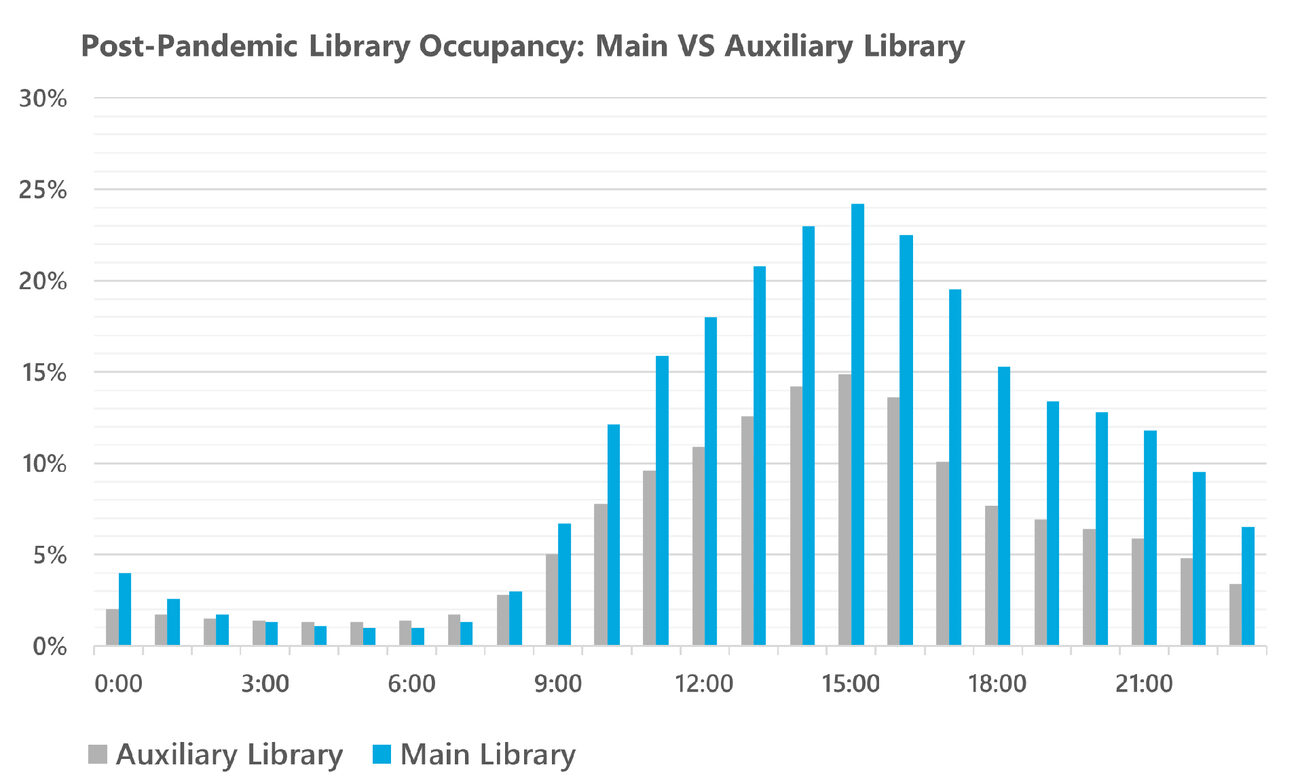
Insight 2: Print Collections Are Not Driving Library Usage
Several years ago, while developing a campus-wide library system master plan, we conducted a peer benchmarking analysis. It revealed that while our client’s budget per student was in line with the average, they had among the lowest space usage, the fewest service transactions, and the highest number of books per student. The story jumped off the page: The library needed to shift resources from collections to people and services, and shift space from collections to study.
This is a story that’s common across many colleges and universities. When put on reserve, showcased in high-traffic areas, curated to respond to a timely topic, or activated through exhibits and programs like author talks, print collections can and do influence library usage. But this is the exception rather than the rule. Our analysis found a very weak correlation (r = 0.282) between the number of print volumes held and the utilization of library space as measured by the daily occupancy peak. As library leaders plan for the future and think about how many seats they need in their library, this finding can inform — and indeed encourage — a shift from stack space to study space. It should also catalyze efforts to curate and showcase collections to drive their usage and enhance teaching, learning, research, and scholarship.
It’s important to note that the sense that library study space is “full” depends on the type of space, how it’s configured, and how it’s used. Many libraries have a perception that students view libraries as “full” at about the 50%-60% mark and only get to 80-90% at finals. The threshold for “full” may also have lowered because of social distancing, isolation, and introversion during the pandemic.
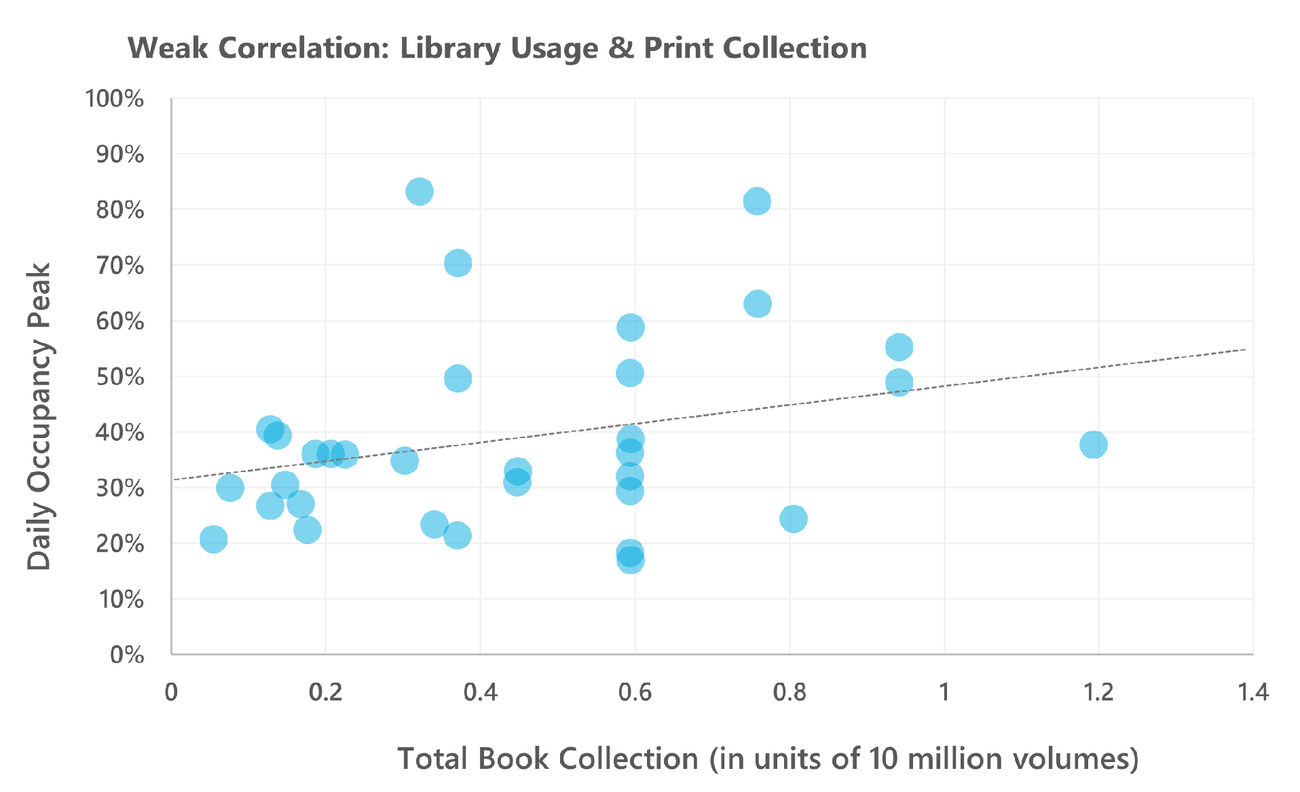
Insight 3: Libraries with Student Success Functions Have 20-25% Higher Usage
After the shift of stacks to study space, the biggest change reshaping library spaces and services is the way that libraries are partnering with other functions within a college or university to offer programming and services that meet students and faculty where they are — in the library! Sometimes “partnership” is really just what we call the “library land grab,” where unrelated functions are foisted upon libraries to fill space that’s vacated by collections as they move off-site into high-density shelving. But more commonly, these partnerships capitalize on shared missions and complementary services, particularly to foster student success. It’s not hard to imagine a student working with a reference librarian to identify additional sources for a project, only to find they’d benefit from a consult with the writing center to hone their thesis, or the data lab to refine the graph in figure 1, or the communication center to polish their presentation.
While we found little relationship between print collections and library usage, it was quite the opposite for the inclusion of student success partners within a library. We compared 23 libraries without student success functions to 15 libraries that included student success functions like writing, tutoring, math centers, and more.
The difference is most pronounced in morning and early evening peaks, with 25-26% higher usage from 9 a.m. to 10 a.m. and 4 p.m. to 6 p.m.
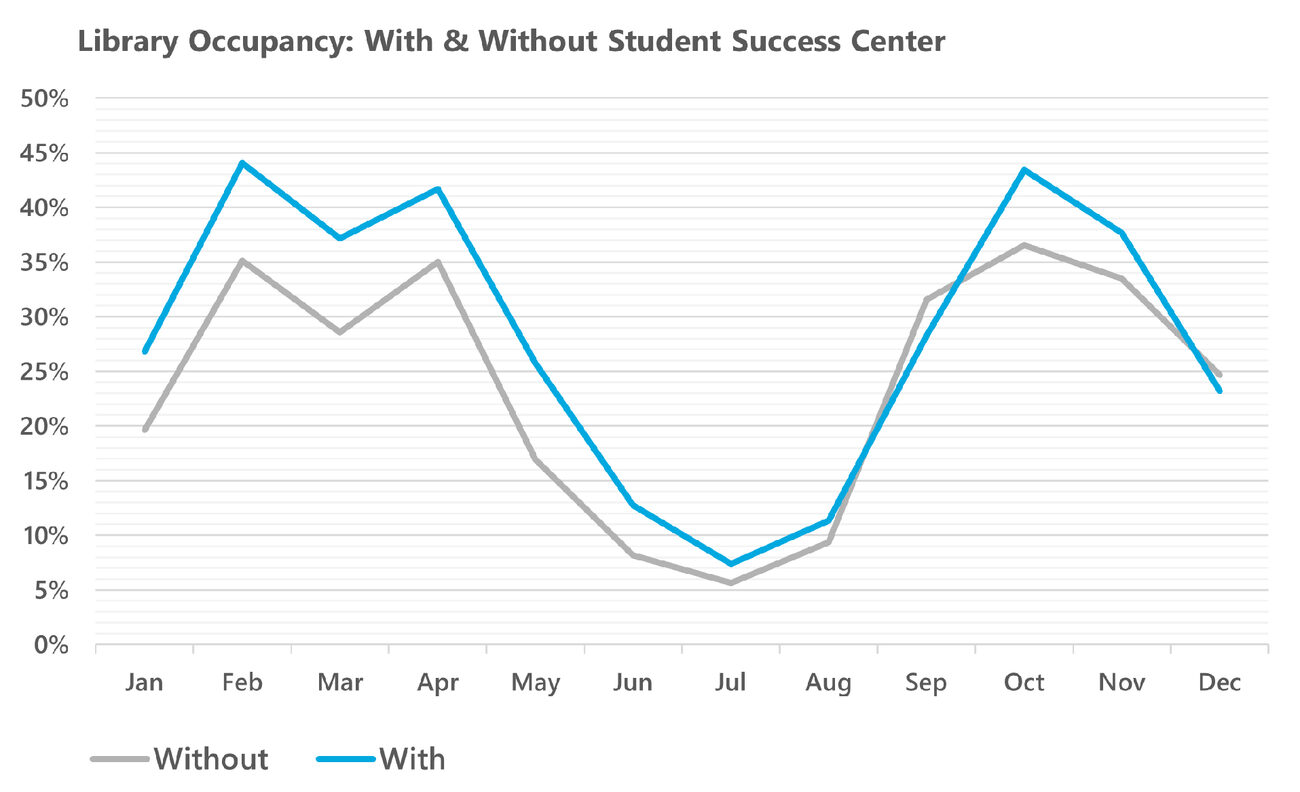
Insight 4: Libraries with Nearby Dining Spaces Have Lower Usage, but Those With Nearby Classrooms Do Not
Libraries used to have a near monopoly on campus study space. Then came the laptop, and students could study and access resources from anywhere. With more mobile students choosing where and when to study, take a break, go to a class, or grab a coffee or a meal, the locations of different functions matter even more. What adjacencies, paths, and spaces along them make for the best flow of people and ideas or the best student experience? As campus planners and leaders in libraries, dining, fitness, and instruction think about what to put where, utilization data can help.
To inform these conversations, we compared the usage of libraries with nearby dining and classroom spaces to see what the impact might be. When it comes to dining, our findings confirm what you might have expected: Nearby dining reduces library utilization around mealtimes. We found occupancy reduced by about 15% at 1 p.m. and 7 p.m. — mealtime peaks — and about 10% between those peaks. The opposite is true for having classrooms near the library: They drive increased usage. Between the core class scheduling hours of 9 a.m. to 6 p.m., we found an average of 27% increased library utilization for libraries with nearby classrooms, with an increase of 36% at 5 p.m., presumably as students get out of class and go to the library.
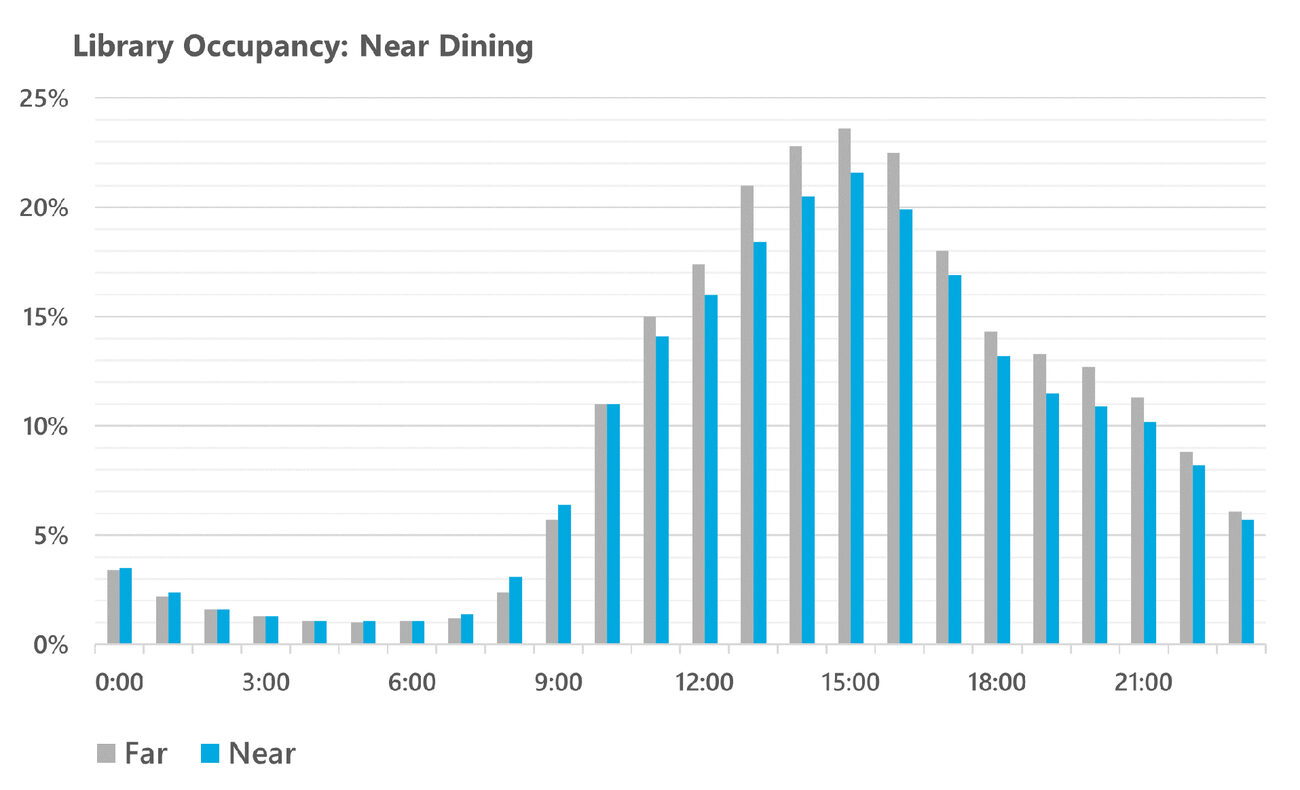
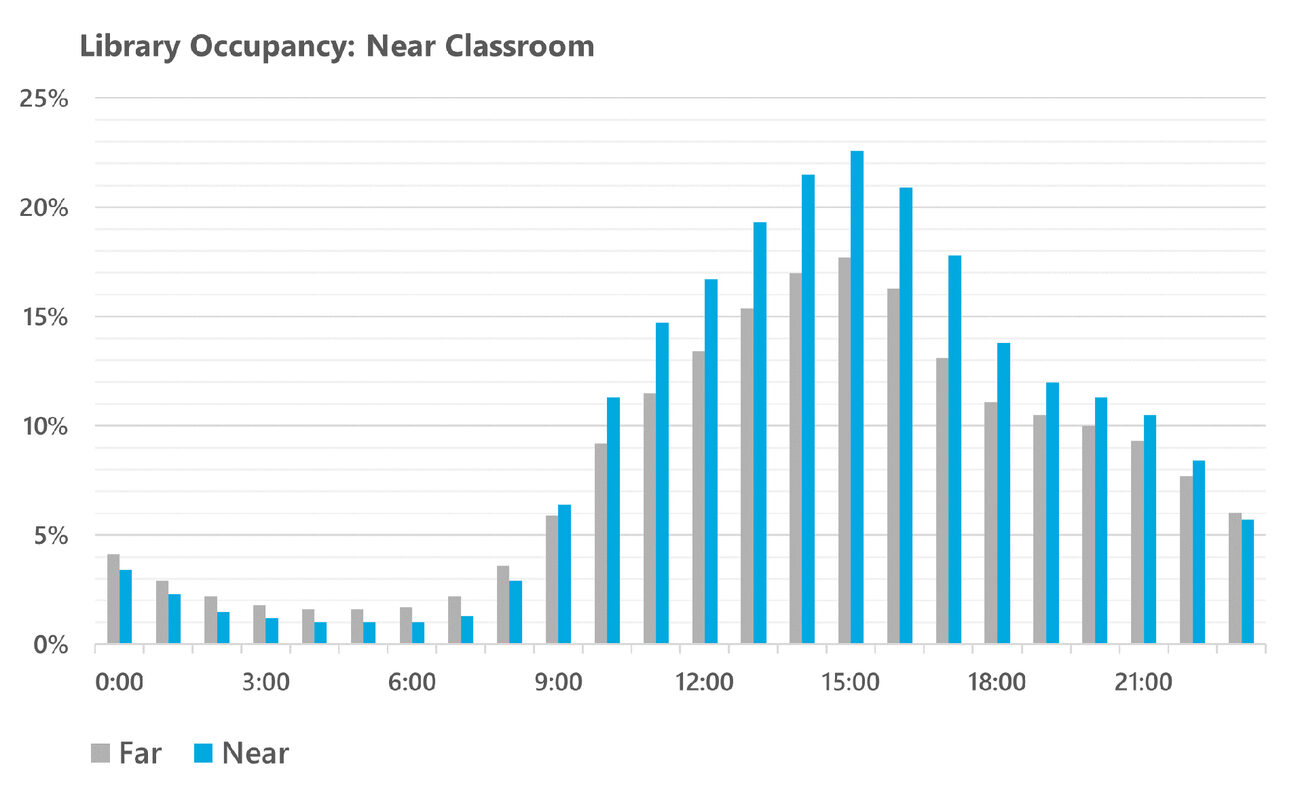
Insight 5: Dining and Fitness Facilities Usage Is Increasing and Shifting Later
Aligning your operating hours and staffing with student demand is complex — and dynamic. Patterns of use change from day to day, week to week, and semester to semester. Weather is a factor. So is the programming and events held elsewhere. Staffing resources are limited. It’s getting harder to fill roles, especially among student employees as wages for off-campus jobs increase faster than on-campus ones.
Anecdotally, we’ve heard from colleges and universities that usage of dining and fitness facilities has shifted to later in the day, and overall usage has increased.
While a small sample size, the data seem to bear this out. Comparing 12 spaces at three universities to 140 spaces at 38 universities, we see increases in usage and later in the day.
Average dining space usage has increased by 40%. The 2019-2020 peak ranged from 75% to 95%, while the 2023 peak is 95% to 125%. The usage from around lunch and dinner increased 30% to 50%, but the usage from 7 p.m. to 11 p.m. increased 60% to 90%. Likewise, the average fitness space usage has increased by 15%. The 2019-2020 peak ranged from 110% to 120%, while the 2023 peak is 125% to 130%. Usage increased by about 40% in the morning, 20% in the afternoon, and 40% in the evening. This data can help to inform decisions around operating hours, such as consolidating all 24/7 locations into one, which also benefits FM and staffing resources.
What you offer also influences how and when you should operate, whether it’s meals or cardio equipment. One university found that cardio equipment use decreased post pandemic — perhaps because students were accustomed to doing this outside of the gym — and strength training increased. So, they shifted the amounts of space and equipment and created “fitness neighborhoods” where students can find their niche (by equipment, scale, etc.) as part of this equipment shift over time. Of the roughly 45 dining spaces measured, approximately 10 had late-night offerings and saw an average drop-off in usage of 13% after 8 p.m. compared to a drop-off of 39% among those who did not.

Insight 6: Workplace Usage May Be Returning to (Comparatively Low) Pre-pandemic Levels
Administrative and academic office spaces typically make up the largest non-residential space on a campus: 19% of total space, according to the Society of College and University Planning (SCUP) Campus Facilities Inventory. This equates to 52 of 265 nsf per student for public, four-year institutions and 72 of 384 nsf per student for private not-for-profit, four-year institutions.
Prior to the pandemic, office spaces were among the least utilized; for example, a typical office or workstation might be used 20% to 50% of the time whereas a typical classroom might be used 50% to 75% of the time or more. Prior to the pandemic, only about 10% of staff and faculty in higher education had the ability to work remotely full time, according to a Pew Research report.
Since then, work patterns have shifted considerably, as staff and faculty move to hybrid and remote work. While the sample size is quite small, encompassing two spaces at one university in 2019 and 15 spaces at two universities in 2023, there are a few things we can conclude. First, at 50% peak occupancy, these office spaces seem to nearly be back to the pre-pandemic peak occupancy of 55%, comparing 2019 and 2023 — with a relatively steady rise to a 25% peak in 2021 and 45% peak in 2022. Second, office spaces in higher education seem to be used less than in other sectors and with much greater fluctuation, presumably due to the academic calendar. Using Stanford Professor Nick Bloom’s Work from Home Research group, we see that time in the office has stabilized at about 67% (gray line in the graph below) since December 2022 whereas in higher education, time in office prior to summer of 2023 was approximately 50% (blue line in the graph below).
While few colleges and universities have good data on office utilization — and more should — many are using anecdotal information and observations to better align the amounts and types of spaces with new work patterns. For example, in the same Campus Facilities Inventory study, of the approximately 100 institutions surveyed, 77% said it was likely or extremely likely that they would create more flexible administrative workspace in next year, and 60% likely/extremely likely that they would create more flexible faculty workspace in next year.
As colleges and universities reconsider their physical office footprint to align with utilization, there are benefits to the carbon footprint as well.
A recent report in the Proceedings of the National Academy of Sciences by Tao et. al. concludes that working remotely two days a week reduces carbon emissions by 11%, four days remotely by 29%, and fully remotely by 58%. Savings would be even greater if accounting for embodied carbon of the facilities colleges and universities avoid building given reduced space needs.
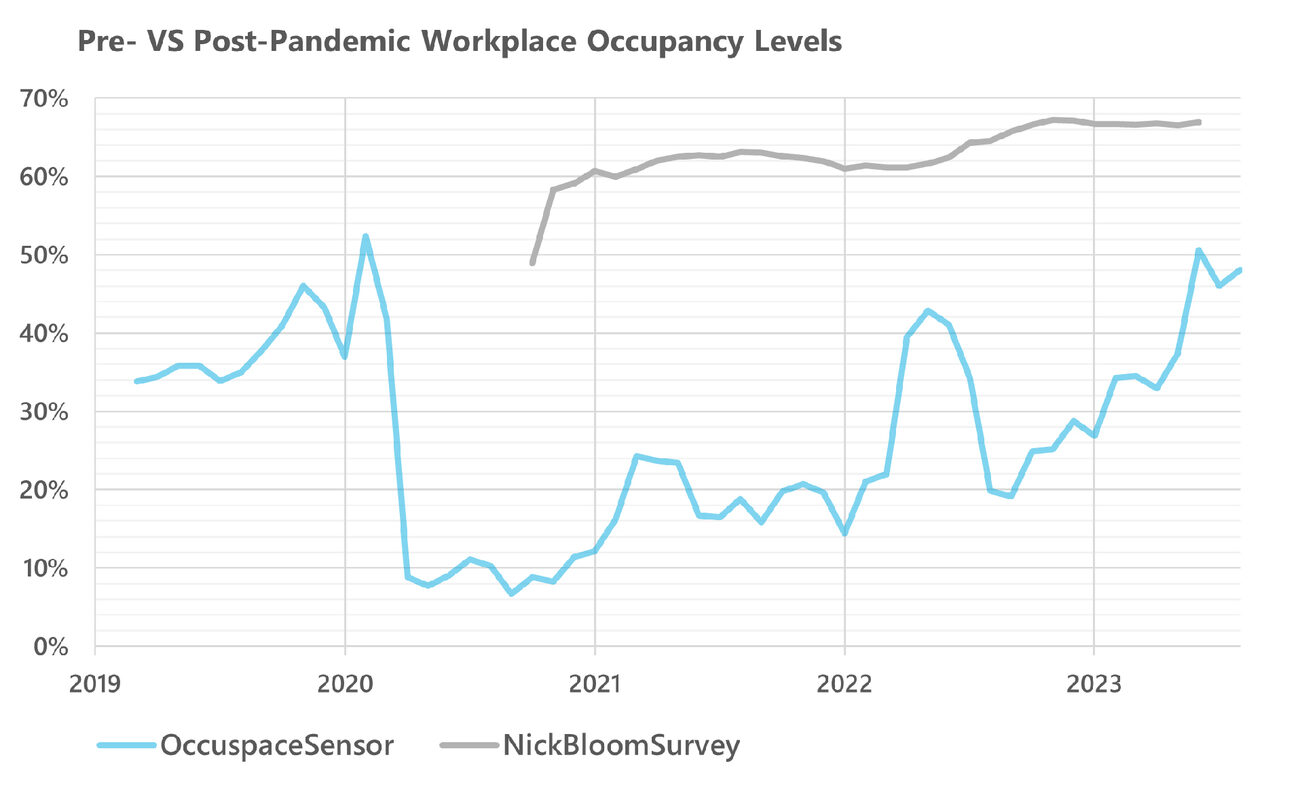
Insight 7: Linking Occupancy Data with Other Analyses Helps Define and Refine What “Full” Means
We convened a roundtable to discuss our findings with about 20 of the 38 institutions whose anonymized data were included in the analysis. These universities shared four lessons learned from measuring occupancy data and advice for other colleges and universities complementing or implementing space utilization technology:
- Having a clear plan before you start allows you to concentrate your efforts on collecting and analyzing occupancy data effectively. One way to focus is to work backwards from the decisions you want to make. Participants’ priority decisions were (in declining order): right-sizing facilities, enhancing student experiences, optimizing operating hours, and consolidating locations.
- Occupancy data is just one measure – and it becomes even more valuable when you can correlate your occupancy data with other data points such as gate counts, staffing levels, proximity, and service offerings.
- The perception of when a space is “busy” or “full” is somewhat subjective, hard to define, depends on the space type and configuration, and changes over time, such as during finals versus the beginning of the semester. For example, with some communal library seating students may feel awkward sitting with a stranger so they choose another table that will then give the perception of “full” more quickly.
- It is evident that students want access to real-time occupancy data. They want to know how full the fitness center, dining hall, or library is – especially if these spaces are in short supply or the trek to them is long. Making the live occupancy data visible is a way to increase awareness of crowd levels and drive usage by lowering barriers to entry.
What’s Next: Dwell Time, Heatmaps, and Predictive Modelling
While the occupancy data has been tremendously useful to inform decision making, how else can we use this data to make decisions and increase efficiencies in space operations and staffing? Thoughts from the 20 institutions in the roundtable, Occuspace’s upcoming features, and brightspot and Buro Happold analytics practice provide three answers:
- Dwell time: Understanding how long occupants remain in a particular area can provide a more detailed view of utilization. Measuring dwell time in spaces can help operators better understand when that location (or services) will become available. It can also help answer questions like “How does usage over time relate to where visitors are, what’s nearby, type of seating, etc.?”
- Heat maps: Visualizing how spaces are used on a floor plan to be able to see the hot spots – and even overlay with a furniture or traffic flow plan – will provide the next level of insight that colleges and universities can use to refine the spaces for optimal traffic, or upgrade furniture, equipment, technology, and/or services they offer, along with when and how they operate them.
- Predictive Analytics: Utilization data provides great insight into facilities planning, design, and operations for historical analysis. The breakthrough is using it to predict future usage, whether it be for occupancy patterns by hour, day, week, month, or semester; for example, how should your staffing change over the course of a semester or how might you rotate space or equipment to even out their usage? How might you adjust operating hours to save money and energy during low traffic times?
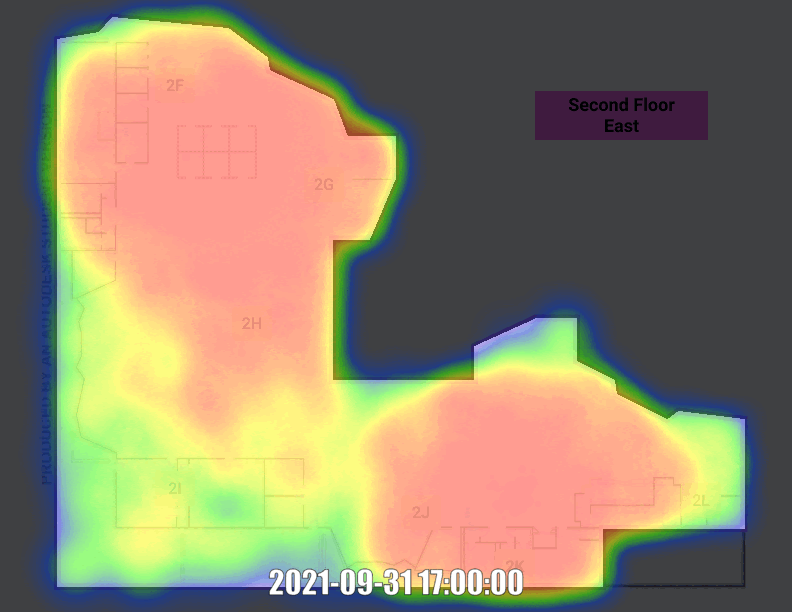
In this white paper, we used anonymized data from 38 universities to help answer questions about how library, fitness, dining, and office spaces are used, and how usage patterns vary. Together, these insights can help leaders in higher education make decisions about consolidating locations, shifting stacks to study space, optimizing adjacencies among different functions on a campus, incorporating student success functions within libraries, aligning fitness and dining operations with demands, and right-sizing the workplace to align with hybrid and remote work patterns.
By Julie Levick, principal, brightspot strategy; Elliot Felix, partner at Buro Happold and founder of brightspot strategy; Yutao Song, lead analytics developer at Buro Happold; and Becky Hayward, associate director of analytics & crowd dynamics at Buro Happold

